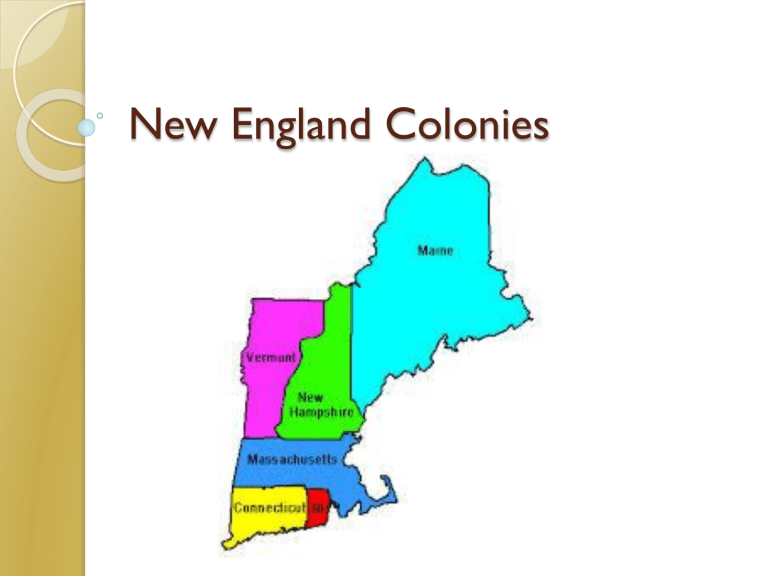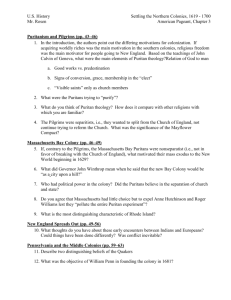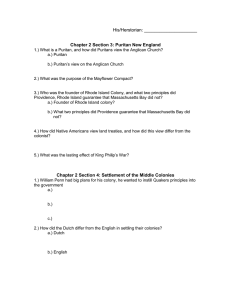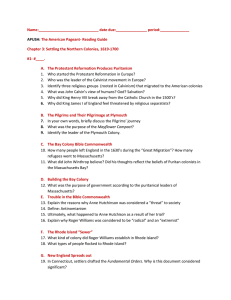
New England Colonies What is a colony? ◦ A colony is a settlement far from the country that rules it. What is a colonist? ◦ A colonist is the person living in the colony. Why did the English want colonies in America? The English wanted to establish colonies in America because they hoped to find gold, other natural resources, and some groups were also seeking religious freedom. Why did people settle in the New England colonies? Massachusetts ◦ (1630) they settled here to escape religious persecution in England. Connecticut ◦ (1636) they settled her for farming, trade, and political freedom. Rhode Island ◦ (1636) they settled here to establish colonies for people of all religions. New Hampshire ◦ (1679) they settled here to trade, for fishing and for religious freedom. Religion in the New England Colonies For religious freedom including; ◦ ◦ ◦ ◦ ◦ Quakers Anglican, Baptist Presbyterian. With the majority being Puritans. Characteristics of the New England Colonies The New England Colonies consisted of Massachusetts, Connecticut, Rhode Island, and New Hampshire. These colonies had thin, rocky soil, making it a very difficult place to farm. It was rich in other valuable resources such as thick woods excellent timber for homes, and the coastal waters were rich with fish and whale. The first colony in this region was Massachusetts. Mayflower Compact In the early 1500s England broke away from the Roman Catholic Church under the leadership of King Henry VIII. He created a new Christian church called the church of England. Some people felt this church was much like the Roman Catholic Church and they wanted to separate from the Church of England. William Bradford William Bradford led the group of separatists and decided to leave England to a settlement where they could worship as they pleased. They became known as Pilgrims. In September 1620, Bradford and his group boarded The Mayflower and their destination was Virginia but instead landed in the New England region. Before landing, the Pilgrim leaders decided to write a plan of government for their colony, the Mayflower Compact. The compact stated that the government would make “just and equal laws…for the general good of the colony.” System of Government Religious leaders were actively involved while the colony struggled to develop a form of government compatible with Puritan beliefs. Political and religious authority was often combined and voting was restricted to church members. This reinforced the Puritan belief that God sent them to cleanse the culture of what they regarded as corrupt, sinful practices. How did Thanksgiving occur? When the Pilgrims finally settled, many were dying due to sickness and starvation. Native Americans began helping them and showing them where to hunt and how to grow corn. When they gathered their harvest in the fall, the Pilgrims invited the Native Americans to a thanksgiving celebration. Roger Williams Many Puritan settlements were built in Massachusetts. They had very strict laws that people were required to follow. Not everyone agreed with all the Puritan laws. Roger Williams spoke out against them because he believed that the government should not punish citizens for what they believed. Because of this, Williams was forced to leave Massachusetts by the Puritan leader. He founded a settlement south of Massachusetts and named in Providence. This was the start of a new colony, Rhode Island. Under his leadership, Rhode Island became the first English colony in North America to offer complete religious freedom to settlers. Anne Hutchinson (1591-1643) She was a Puritan leader banished from Massachusetts for her religious views. She was another dissenter who angered Puritan leaders in Massachusetts. She believed that a person’s own faith in God was more important than the church’s rules and laws. She held religious discussions in her Boston home. She taught that faith alone, not membership in the organized church, was enough to be considered a good Christian. John Wise (1652-1725) He was a political leader in Massachusetts during The American colonial period. He was noted for his protest against British taxation. Quakers Quakers were another religious group whose beliefs differed from those of other churches. Quakers had no priests or ministers. They would not fight in wars. English Quaker, William Penn, was jailed several times for his beliefs. He wanted to start a colony where Quakers could live safely. In 1681, England’s King Charles II granted land in North America to Penn. Penn founded Pennsylvania there. Penn welcomed people from many countries to his colony. They practiced different religions. Penn also treated American Indians with respect. Therefore, they lived in peace with the colonists. Puritans Sailed from England to North America in search of religious freedom. They wanted to “purify” or reform the Church of England. Like the Pilgrims, the Puritans faced persecution in England. Many were put in jail for their beliefs. The Puritans were led by John Winthrop. Winthrop believed that the Puritans should build their own colony in New England. Puritan towns were carefully planned. Each family had its own land on which to build a home and a farm. Pilgrims The story of Pilgrims began in England during the early 1500’s. At this time, England broke away from the Roman Catholic Church. England’s King Henry VIII created a new Christian church called the Church of England. Everyone in England had to belong to this church. A man named William Bradford was a leader of a group of Separatists. Bradford’s group decided to leave England and start a settlement of their own, where they could worship as they pleased. These colonists became known as the Pilgrims.






